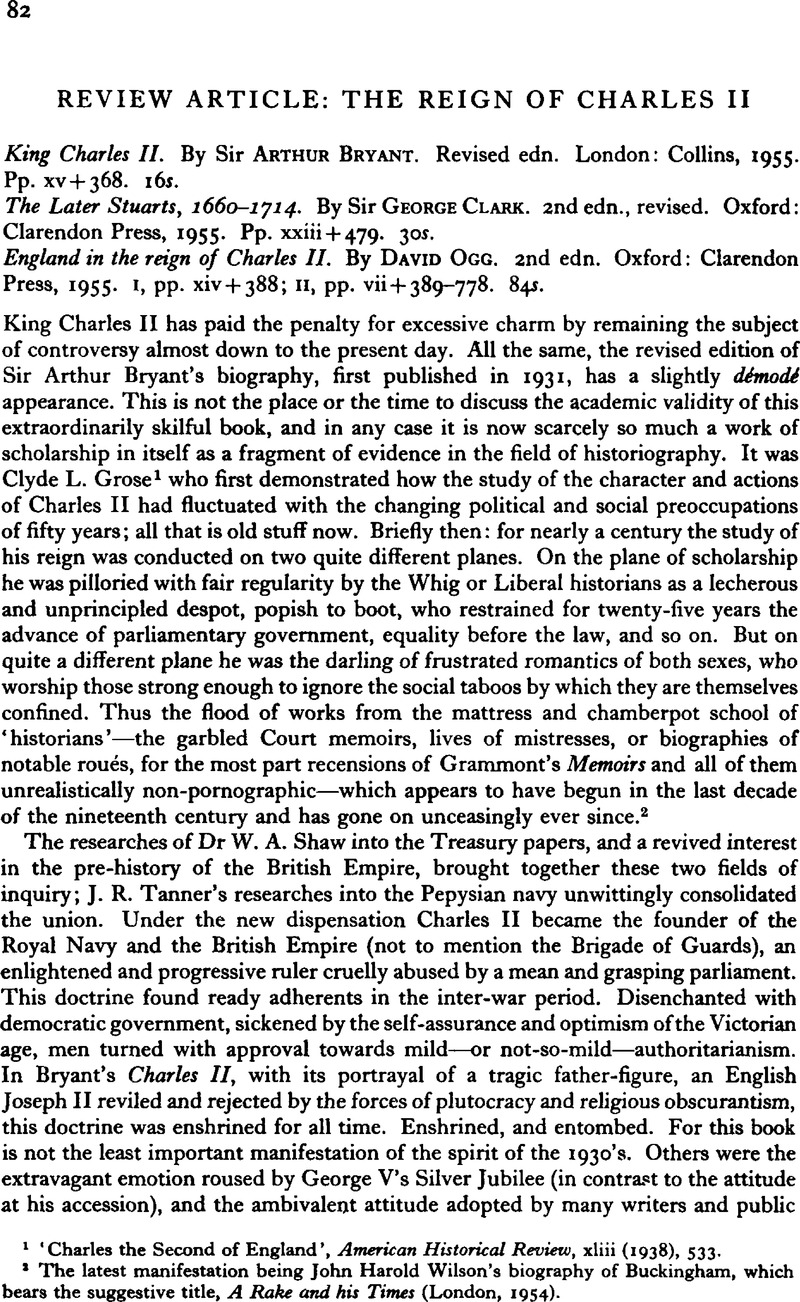Published online by Cambridge University Press: 20 December 2011

1 ‘Charles the Second of England’, American Historical Review, XLIII (1938), 533.Google Scholar
2 The latest manifestation being John Harold Wilson's biography of Buckingham, which bears the suggestive title, A Rake and his Times(London, 1954).Google Scholar
3 I am told that its American sales were comparatively trifling—a significant fact, if true.
4 Exceptions, of course, are monographs which deal conclusively and finally with a limited field of fact and are therefore not open to general criticism. But these are few.
5 ‘Party and party organisation in the reign of Charles II’, Transactions of the Royal Historical Society, 4th ser., XXX (1948), 21.Google Scholar
6 Mr Godfrey Davies, with various assistants, has also published several highly specialized papers in the Huntington Library Quarterly. Noneof them possesses any very wide significance.
7 I am aware that Dr J. Rees Jones has completed a study of ‘The Whigs 1678–84’, but here I can only deal with published work. In any case, so far as I know he is alone.
8 Miss Dorothy Thirsk's research into the difficult question of royalist lands has not yet reached a stage definitive enough to make it applicable to political problems. Cf. her articles in Economic History Review, V (1952), 188Google Scholar, and Journal of Modern History, XXV (1954), 315.Google Scholar Professor H. J. Habakkuk is now turning his attention to this period, but I was net fortunate enough to hear the paper he read on the subject to the last Anglo-American Conference of Historians (1956).
9 ‘The Long Parliament of Charles II’, Pt 1, English Historical Review, XXI, 21.
10 Ibid XLIV, 400, XLV, 58
11 With the outstanding exception of a too-brief article by de Beer, E S on ‘The House of Lords in the Parliament of 1680’, Bulletin of the Institute of Historical Research, XX (1943), 22CrossRefGoogle Scholar
12 Too much has been made of the Commons Resolution of 3 July 1678 on money bills. As late as 1739 it could be challenged by Carteret, and in 1740 and 1741 Lord Chancellor Hardwicke twice denied its validity
13 Cf. ‘Daniel Finch, 2nd Earl of Nottingham, his house and estate’, Studies in Social History, ed. Plumb, J. H. (1955), 139Google Scholar, and ‘English Landownership, 1680–1740’, Economic History Review, 1st ser., X (1940), 15.Google Scholar Also ‘Marriage settlements in the eighteenth century’, Transactions of the Royal Historical Society, 4th ser., XXXII (1950), 15.Google Scholar
14 I have left out of account the work done in recent years on the political theory of the reign. The most useful items, perhaps, for the political or social historian are: Fink, Z. S., The Classical Republicans (Evanston, 1945)Google Scholar; Behrens, Miss C. B., ‘The Whig theory of the constitution’, Cambridge Historical Journal, VII (1941), 42–71CrossRefGoogle Scholar; and Mr Peter Laslett's edition of Filmer's, Sir Robert Patriarcha (Oxford, 1949).Google Scholar